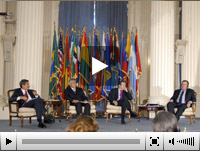- English
Cátedra de las Américas
Thirty Third Lecture - Rafael Rangel Sostmann, Michael M. Crow, Raúl Bao García
Thirty Third Lecture - February 4, 2009
"The Challenges of Globalization and the New Role of Universities in the Hemisphere”
Oradores: Rafael Rangel Sostmann, Rector, Instituto Tecnológico y de Estudios Superiores de Monterrey, Michael M. Crow, President Arizona State University and Raúl Bao García, President, Universidad San Martín de Porres
In the XXXIII Lecture, the leaders of three of the most prestigious universities in the region exchanged ideas about the role that universities should play in a globalized world and discussed policies that can offer the best alternatives to university graduates.
The three scholars discussed whether universities should be centers for scientific and academic research and innovation or centers for planning and implementation of public policy. Dr. Crow stated that he believes universities in the Americas must remain centers of innovation and creativity and should attempt to expand their historical role and purpose in society. Dr. Bao, on the other hand, believes that universities should focus on academics, as the professionals that they are preparing are potential sources of additional capital for their respective countries.
Dr. Rangel noted that universities in Latin America tend to publish books on studies pointing out what is wrong, but are typically not proactive and do not create the models their countries need. “If the governor in the region does not know that a technological park will help the region’s economic development, then we have to help him to create this park, to attract investment, to create technology-based businesses”. In his view, universities have to help legislators make policy and stress why certain policies are important to the legislators.
In regards to the democratization of education and the links between education and the community, Dr. Crow explained that in order to become a university built on democratic principles, Arizona State University (ASU) has been restructuring its institutional design by doing what he calls “genetic organizational engineering.” That is, the university has been engineering how the institution is structured and what its principles and design aspirations are. Its location, network of people, and the surrounding community they serve are as important as the structure of the institution. “For example, one of our objectives is social embeddedness, so we take the faculty in our architectural program and in a range of other programs, and focus them on trying to find ways to build affordable housing for people with lower incomes.” That process becomes embedded into the curriculum and then is designed into a part of the mission of the institution, becoming an intellectual objective.
He also spoke on taking responsibility for the quality of education, admitting that if the public schools are deteriorating in their performance, it is, at least in part, a result of the public universities’ own action: underprepared and undereducated teachers. That is why ASU created a program called “Teacher Tracking” where they track every teacher’s performance as they go out into the schools.
Dr. Bao suggested that one of the fundamental goals of any university should be build a relationship with the community and integrate the university with society. In his view, Techno Parks succeed in the developed world because universities are seen as hatching grounds for models and incubators of business in the private sector. We are trying to develop such a culture in Perú. To the extent that the private sector entrusts their projects to universities, the latter will better satisfy the research and development demands that private business and industry desire. Dr. Bao also pointed out that universities must not lose sight of their relation to the State.
Finally, the three speakers discussed whether the current prevailing ranking system is fair. Dr. Rangel contends- and his colleagues agree- that it is a mistake to continue to rely on a single, across-the-board paradigm.

